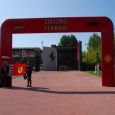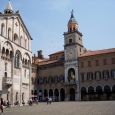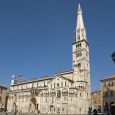Modena
Advertisement
By Air
The nearest airport is “Guglielmo Marconi” of Bologna, which is about 6 km from Bologna train station and 40 km from Modena.The fare is € 12,00 per person.Tickets can be bought on bus. Baggage is free and minors accompanied by at least two relatives travel free of charge.
By Train
Modena railway station, opened in 1859, forms part of the Milan–Bologna railway, and is also a terminus of two secondary railways, linking Modena with Verona and Sassuolo, respectively.
By Bus
Modena's urban public transport network is operated by ATCM.The network includes the Modena trolleybus system.Modena can be reached by any of a large number of suburban buses, which connect it to the most relevant villages of the surrounding Province (Carpi, Sassuolo, Fiorano, Campogalliano, Correggio, Soliera, Vignola, Pavullo, Nonantola, Maranello and others).The transport company in the whole Province is ATCM (Azienda Trasporti Collettivi e Mobilità).The surface of the Province of Modena is divided into 41 districts, each with a different fee; the ticket is valid for a certain amount of time since you get on the bus, depending on the specific district.
Modena Cathedral
is a Romanesque church in Modena, Italy.It is the cathedral, or duomo in Italian, of the Roman Catholic Archdiocese of Modena-Nonantola.Consecrated in 1184, it is one of the most important Romanesque buildings in Europe and a World Heritage Site.Two previous churches had been constructed on the site since the 5th century, but they had both been destroyed. Work on the modern Cathedral began in 1099, under the direction of the master builder Lanfranco, over the site of the sepulchre of Saint Geminianus, Modena's patron saint. The Saint's remains are still exhibited in the cathedral's crypt. The present cathedral was consecrated by Pope Lucius III on July 12, 1184.After Lanfranco's work, the Cathedral was embellished by Anselmo da Campione and his heirs, the so-called "Campionese-masters". The current façade therefore exhibits different styles. The majestic rose-window was added by Anselmo in the 13th century, while the two lions supporting the entrance's columns are of Roman age, probably discovered while digging the foundations.
Ducal Palace
The Palace, begun by Francesco I d'Este in 1634 and finished by Francis V, was the seat of the Este court from the 17-19th century. The palace occupies the site of the former Este Castle, once located in the periphery of the city. Although generally credited to Bartolomeo Avanzini, it has been suggested that advice and guidance in the design process had been sought from the contemporary luminaries, Cortona, Bernini, and Borromini.The Palace currently houses the Accademia Militare di Modena, the Military Museum and a precious Library.The Palace has a Baroque façade from which the Honour Court, where the military ceremonies are held, and the Honour Staircase can be accessed. The Central Hall has a frescoed ceiling with the 17th century Incoronation of Bradamante by Marco Antonio Franceschini. The Salottino d'Oro ("Golden Hall"), covered with gilted removable panels, was used by Duke Francis III as his main cabinet of work.
The Palace Museum
is a Museum, on the St. Augustine square, is an example of civil architecture from the Este period, built as a Hostel for the Poor together with the nearby Hospital in the late 18th century.Today it houses the main museums of Modena.Estense Gallery, with works by Tintoretto, Paolo Veronese, Guido Reni, Correggio, Cosme Tura and brothers Annibale and Agostino Carracci.The most famous works are the two portraits of Francis I d'Este, a sculpture by Gian Lorenzo Bernini and a canvas by Diego Velazquez.
Estense Library
established in Modena in the seventeenth century, is one of the most important libraries in Italy.The library is located in the Palazzo del Musei, Off Via Emilia, at Piazza Sant'Agostino 48.Today the Library's collection contains more than 380 000 printed works, about 3 000 manuscripts, and 1 640 incunabula.Of these, the most famous is the 1 200-page Bible of Borso d'Este, bordered with miniatures.this contains printed books, sixteenth century incunabula and numerous illuminated manuscripts from the 14th to the 16th centuries.The most precious text is the famous Borso D'Este Bible, a masterpiece of Ferrara illumination (15th century).
Hortus Botanicus Mutinensis
is a botanical garden operated by the University of Modena and Reggio Emilia.It is located next to the Garden Ducale (Public Gardens), at viale Caduti in Guerra 127, Modena, Italy, and open weekdays during the warmer months except August. Admission is free.The garden was established in 1758 by Duke Francesco III d'Este for medicinal plants, becoming part of the university in 1772. The garden is an irregular shape, almost 1 hectare in size, with several greenhouses (total area 300 m2) running in a line across the garden's center. It currently contains about 1,400 species plus a major herbarium.
February - June
August - December






